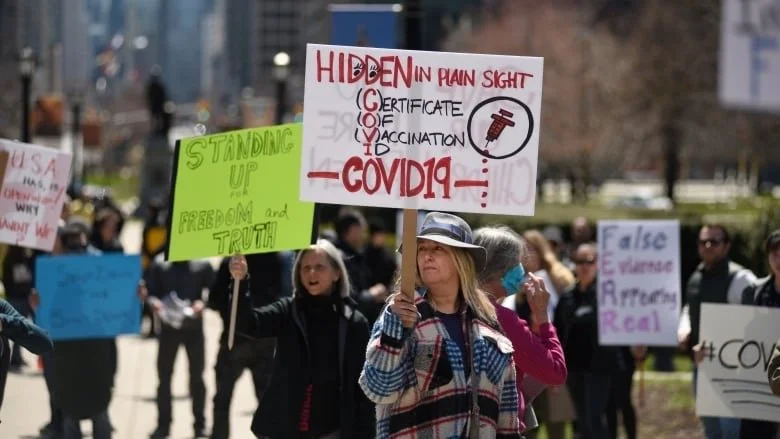ANALYSIS: Debunking COVID Conspiracies
Arindam Shivaani/NurPhoto/Getty Images
Near the beginning of the COVID-19 Pandemic, conspiracy theories began to spread throughout the world, primarily on social media. Many theorists, blinded by fear, not only believe the theories, but spread them to others. Many would agree that the spreading of false information is a pandemic in itself.
One of the more well-known theories is the microchip vaccine. The theory suggests the existence of the virus to be fake, and is just a cover to give people a reason to get a vaccine shot that injects trackable microchips in a person’s body. Bill Gates, Microsoft’s co-founder, is supposedly the one behind it all. Despite the lack of any evidence, this COVID-19 vaccine theory is still widely discussed and believed. In fact, a YouGov study shows that 20 per cent of people in the age range of 30-44 are saying it’s “probably true.” This theory gained exceptional popularity in late 2020 and early 2021 following the rollout of vaccines.
Conspiracy theorists have also stated that COVID-19 death statistics are supposedly being faked for shock and scare factor. Max Igan, an influential Australian internet conspiracy theorist made a post on a video hosting service well known for harbouring hate speech, titled “If People Get Jabbed After Watching This They Are Beyond Saving.” As the title suggests, the video is about why one shouldn’t get the vaccine and mentions related conspiracy theories. In the video, he states that even if one did not receive a vaccine, the chance of death is extremely low. In his own words, “According to the government’s own statistics and good old fashioned math, your chances of surviving COVID-19 without the experimental injection depends on your age group. 0-14, survival is 99.998 per cent. 15-44, survival is 99.9930 per cent. 45-64, survival is 99.9294 per cent. 65-85, survival is 99.6297 per cent. And over 85 survival is 98.2499 per cent. The numbers don’t lie!” Needless to say, these statistics have been proven false. While it is true that children and young adults are less likely to die of COVID-19 when compared to older age groups, the statistics he cites are both incorrect and give false impressions of COVID-19 cases. In fact, a recent report by the BC Center for Disease Control (BCCDC) shows that unvaccinated people are 53 times more likely to die than those who have received both of their shots. This, of course, adjusts depending on age.
That same video has more than 20,000 shares on Facebook, with over 300,000 views as of October 2021.
Social media plays a large part in keeping conspiracy theories alive and spreading them, as the articles, posts, and multimedia are easily accessible for anyone with an internet connection. Social platforms including Facebook, TikTok and YouTube have outperformed credible news sources when it comes to COVID-19 related news, according to a SmithGeiger and Futuri’s Audience and Revenue study.
According to journalist and researcher Orge Castellano, “Algorithms have aggravated the current problem of conspiracy thinking on the internet.” Algorithms influence what we watch, what we search and in many cases what we begin to believe. When things are trending, others want to be a part of the trend. It often does not matter if the person knows they should not be following along. As long as they get the views or likes, they are content.
An example of this is how Facebook often has misinformation trending. According to BuzzFeed News, “Fake news stories keep trending because people on Facebook keep reading and sharing and liking them — and the review team keeps siding with the algorithm’s choices.” After a certain point, the misinformation becomes too powerful to stop, as it’s already been brought into the physical world. “Social media curates the ‘news,’ so you are more likely to see a story that agrees with your worldview and motivates you to take a path that is more consistent with that worldview,” Rob Enderle, principal analyst at the Enderle Group stated.
Aside from social media, pandemic misinformation is readily available offline and in the physical world, usually in the form of protests. While these protests are the majority of the time peaceful, they can also get verbal and violent, such as Italy’s infamous Green Pass protest. This leads to accidents and fights, and measures by the police are often taken, such as blocking the roads to protesters and diverting traffic.
Within a week of the BC’s announcement of proof of vaccination, two protests against the system had taken place in Vancouver, one of which took place in front of a hospital. On September 1st, many gathered near Vancouver General Hospital and made their way to City Hall showing their opposition to the new passport system and COVID restrictions in general. Protesters chanted “Lock her up” repeatedly, referring to Dr. Bonnie Henry outside the hospital. As CBC News mentioned, “In downtown Vancouver, many in the majority white crowd carried signs comparing themselves to historic victims of genocide and other forms of violent racial and ethnic discrimination.”
As Fight Fake News, a project of Louisiana State University puts it, “The conspiracy theory problem doesn’t remain in the confines of social media; conspiracy theories have real consequences for society.”.

